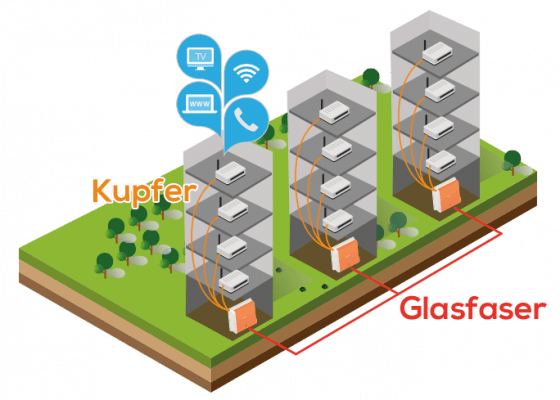IP TV, streaming or cloud services require fast and reliable Internet. Fibre optic cables are of course the best solution. But large bandwidths can also be achieved with classical copper lines. Thanks to G.fast technology. Our partner DZS provides high-performance Distribution Point Units (DPUs or DSLAM) for such applications in its MileGate Series.
The hunger for bandwidth is growing. Web TV, video-on-demand from Netflix, Amazon Prime & Co. or (business) applications from the Cloud require high-performance connections. Private consumers and companies need blanket coverage with connections that offer data rates of 50 Mbit/s and higher. The best solution for the broadband network is fibre optic cables. But fibre optic has not yet been laid everywhere; installation of the high-speed network is advancing at a slow pace.
Network operators usually use various combinations of copper cable and fibre optic lines. The critical point as far as broadband is concerned is how far the fibre optic cable is from the end-user. The different variants are Fibre To The Curb (FTTC), Fibre To The Building (FTTB) or Fibre To The Home (FTTH). There is rule of thumb that says the nearer the fibre optic cable is to the home, the higher the data rate.
In many cases, slower copper cables are used for connection within the building. As its name suggests, G.fast technology accelerates this “last mile” to bandwidths from 500 MBit/s to 1 GBit/s. G.fast is standardised (ITU-T G.9701) by the ITU (International Telecommunication Union) and stands for “Fast Access to Subscriber Terminals”.
G.fast utilises vectoring
The technology is primarily used in existing buildings with multiple residential units and FTTB connections where the fibre optic cable reaches the building basement. From there, it continues as copper cable to the individual flats and the subscriber’s terminal (“last mile”). G.fast turns the last mile into a data highway. In theory, this technology reaches a data rate of 1 GBit/s with the addition of upstream and downstream on the basis of copper, whereby it would be realistic to assume a bandwidth between 600 and 700 MBit/s. In comparison VDSL2 reaches up to 150 MBit/s; cable networks usually have data rates of 200 to 400 MBit/s.

G.fast achieves this bandwidth by means of vectoring, high frequencies for data transmission, a new error correction method and the bundling of upstream and downstream. However, users need a new router that supports the new technology. G.fast is comparable with DSL but uses much higher frequencies for data transmission. Whereas VDSL2 uses frequencies up to 17 MHz, the first stage of G.fast uses frequencies up to 106 MHz, and in the second generation this will be up to 212 MHz. As more bits can be transmitted in a broader frequency range, the bandwidth will expand and data will be transferred at a higher speed.
However, with high frequencies on unshielded cables there is also a significantly increased risk of crosstalk. G.fast needs vectoring to solve this problem. Background: the copper wires to the end-user are usually buried in the ground in bundles with up to 200 subscriber units. When crosstalk occurs, there is interference between signals in adjacent cables, i.e. the signals overlap and cause mutual interference. The consequence is extreme fluctuations or a reduction in the transmission rate.
With the aid of vectoring, crosstalk between signals can be largely compensated, thus improving the bandwidth. This occurs at the access nodes, from which the copper cables are routed to the subscribers. With vectoring, multiple copper wires are bundled to form a logical group, the so-called “vectored group”, and the interference from all lines and frequencies is analysed and eliminated.
G.INP error correction method and bundling of upstream/downstream
The G.INP (Impulse Noise Protection) error correction method is a further important factor in G.fast’s greater bandwidths and reliability. In contrast to the traditional method of impulse interference protection – as used by VDSL up to 17 MHz for example – no additional check bits are transmitted with G.INP. These form a checksum to find out whether the data packet received is free of errors and was correctly transmitted. As the check bits are no longer transmitted, there is no loss or only a low loss of rate with the bandwidth.
A further special feature is that, thanks to TDD (Time Division Duplex), upstream and downstream can be scaled with G.fast at the operator’s discretion. As the TDD process separates the transmission and reception channels, transmission always takes place alternately in one direction at short intervals. G.fast’s theoretical 1 GBit/s therefore represents a large collective bandwidth that can be flexibly allocated to the upstream or downstream. Then, per DPU for all terminals in a building, the network operator can set the percentage of the available data rate to be used for downstream or upstream. Possible ratios could be 75/25, 90/10 or 50/50, for example.
G.fast DPUs from DZS for expanding FTTB
DZS designed its G.fast DPUs (Distribution Point Units) especially for FTTB (Fibre To The Building) installations and use in apartment buildings. The result is transmission rates via copper cable as previously only known from fibre optic cable. The MileGate 205x, MileGate 204x families and MileGate 2144 DPUs permit trouble-free migration to larger bandwidths with VDSL2. A network operator can start with VDSL2 and switch to G.fast as demand rises.

Questions?
Just ask!
I am Alexander Zagler from the HCD sales team. I will be happy to advise you or assist you with any questions. You can phone me on +49 89 215 36 92-0 or reach me using our contact form.
Contact us
 Deutsch
Deutsch